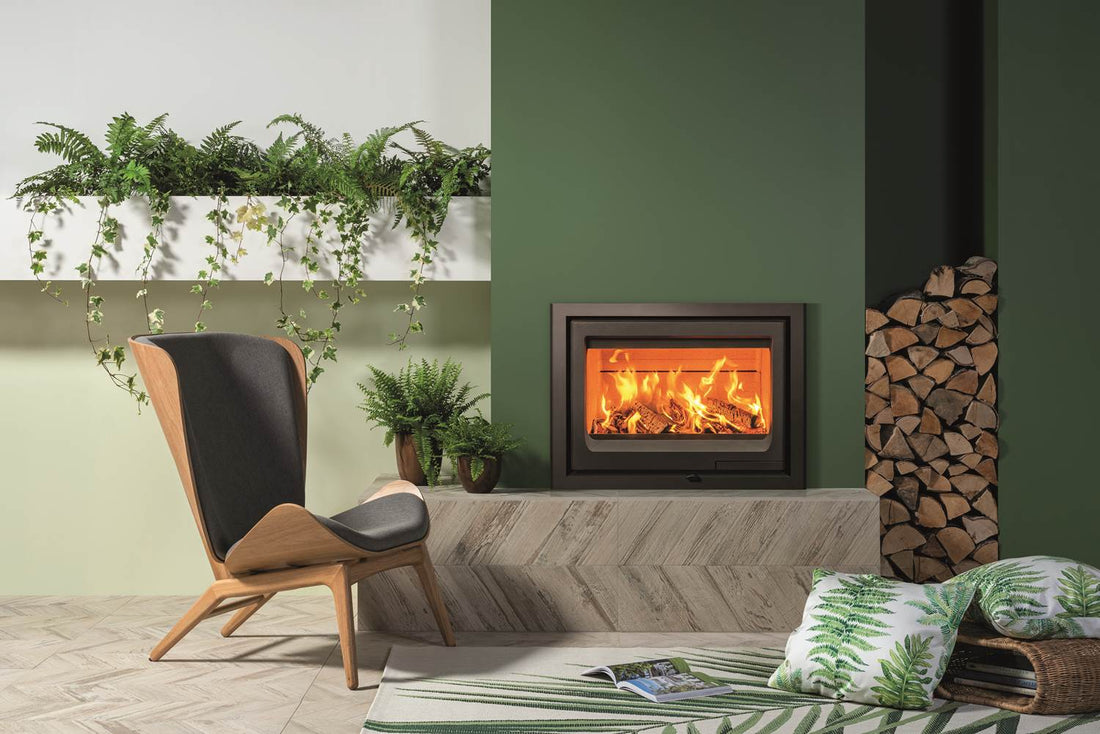
Am I still allowed to have a wood-burning stove in the UK?
Share
From Jan 1, all new wood-burning stoves must meet EU eco standards. Here’s what you need to know. (By Jane Dowle, Sunday September 19 2021, 12.01am, The Sunday Times)
Just when you thought you understood all the rules relating to wood-burning stoves — kiln-dried logs, check; annual chimney sweep, check — along comes another eco-regulation to observe if you want to enjoy crackling flames with a clear conscience this winter.
From January 1, 2022, all wood-burning and multifuel stoves sold in the UK must meet “Ecodesign” standards by law. So if you’re thinking of upgrading before the leaves start to fall, look for this label.
Wood-burning stoves are the latest object of lust to join our ever-growing list of green concerns; you may already be agonising over whether to swap your gas- guzzling boiler for an air source heat pump, or upgrading the fridge to A-rated appliance for maximum energy efficiency. Although the incoming Ecodesign rules have their roots in European Union legislation, they slot neatly into the government’s Clean Air Strategy and form part of the prime minister’s public drive towards achieving net-zero carbon dioxide emissions by 2050.
You may still find non-Ecodesign stoves on the market, but next year it will be unlawful to continue manufacture. And, before you ask, Ecodesign rules were incorporated into the EU (Withdrawal Agreement) Bill, so Brexit hasn’t made any difference.
“Ecodesign regulations for solid fuel heating appliances will of course play a part in helping reach our net-zero goals, just as government regulation on the sale of wet wood and house coal that came into force earlier this year will help too,” says Erica Malkin, the communications manager for the Stove Industry Alliance (SIA). “A modern Ecodesign-compliant stove used with good-quality, dry-wood fuel that has been professionally installed and is well maintained, including regular chimney sweeping, is a very low-carbon heating solution that uses renewable and sustainable fuel.”
It is important not to get Ecodesign confused with Defra (Department for Environment, Food and Rural Affairs) exempt, a requirement that should already be familiar to homeowners looking for a wood-burner that doesn’t break pollution laws in smoke-controlled areas.
“The two terms are very different,” says Mark Ryan, the managing director of Jotul UK, a stove manufacturing company. “Defra is concerned with air quality and smoke-controlled areas. The Clean Air Act states wood cannot be burnt in certain regions unless on approved appliances that qualify to the set emission levels and therefore are Defra-exempt. Ecodesign Ready is all about efficiency and making sure the stoves have qualified to certain strict criteria and are clean-air approved.”

The Ecodesign mark means that a stove has been independently tested by an approved laboratory and meets the criteria on air quality and particulate emissions set out by the EU Ecodesign regulations. These apply to other energy appliances too, including cookers.
Five measures form the criteria: seasonal efficiency (the true energy efficiency of heating and cooling devices during a period of one year), plus the levels of NOx (nitrogen oxides), CO (carbon monoxide), PM (particulate matter) and OGCs (organic gaseous compounds) issued when fuel is burnt.
“For homeowners, Ecodesign stoves will result in cleaner combustion, meaning that they will burn off excess, unwanted gases before they can reach the atmosphere,” says Jon Butterworth, the sales director at Arada Stoves.
To be fair, we’ve had plenty of warning about this. UK stove manufacturers have been introducing SIA Ecodesign Ready models since February 2017, when the regulations were announced in parliament.
There’s more to come, however. The SIA has created its own UK-only registered approval scheme, clearSkies Mark, in conjunction with its own members, chimney system manufacturers, appliance testing laboratories and biomass experts. Malkin says that in due course clearSkies will supersede SIA Ecodesign Ready, a strong indication that whatever measures the government comes up with next regarding wood-burning stoves, the industry is ready.
“The clearSkies scheme is the only appliance certification scheme that combines verification of Ecodesign compliance and Defra exemption into one easy to understand mark,” Malkin says. “All clearSkies level 3 and above certified appliances can be legally used to burn wood in a Smoke Control Area because the Defra exemption certification has been checked by the scheme administrator.”

If you are still confused, here’s a helpful guide.
My stove is ten years old. Will there be penalties?
There will be no penalties at present for homeowners who own and operate a stove that is not Ecodesign-compliant, requirements for Defra exemption if living in a Smoke Control Area notwithstanding (see below), says Malkin.
If you’re considering upgrading to a more efficient and safer new Ecodesign Ready model, expect to pay from £550 to £1,000 for the stove, plus installation. You may need to improve the chimney and/or flue too; seek advice from a registered
professional via Hetas (Heating Equipment Testing and Approvals Scheme).
How does it actually work?
Ecodesign Ready stoves have been engineered to burn wood more completely than older models, says Phil Wood, the UK country manager for the Swedish wood- burning stove company Contura. “The targeted introduction of combustion air at higher levels in the firebox of the stoves reignites the combustion particles before they can leave the stove. This technology reduces particulate emissions by 90 per cent compared to an open fire, or 80 per cent compared to a stove of five to ten years old.”
If I upgrade, what should I do with my old stove?
There is no centralised industry scrappage scheme, but some retailers and manufacturers offer incentives if you’re upgrading. These include the Stove and Fireplace, which gives up to a £200 trade-in on a new stove and installation costs, and Ecco Stove offers £150 to £400 cashback on your old stove, depending on the model and the new purchase.
Otherwise, recycle at a local recycling centre or through a properly registered waste disposal company. For more information visit environment.data.gov.uk.
Will I be penalised if I sell my home with a non-compliant stove?
Not at the moment because your stove will have predated the new legislation. If you buy a non-compliant stove after January there may be an issue during the conveyancing process. It might be the case that a registered installer can’t legally fit it for you, although this cannot be confirmed by the SIA with any certainty at this stage. Proof that a stove has been legally fitted by a registered installer, in the form of a certificate of compliance, is usually required.
How to find a new Ecodesign Ready stove
There’s an official list of independently verified SIA Ecodesign Ready stoves from a number of leading manufacturers on the SIA website.
Anything else I need to know?
“Look out for a stove that features a clean burn system — this means it burns more efficiently and for longer periods of time, resulting in a combustion with very low particle concentration,” Wood says.
What wood to burn
Always buy seasoned, dry or kiln-dried kindling and wood from an accredited supplier; find one through Woodsure, the UK’s wood-fuel accreditation scheme. Look for “Ready to Burn” certification. This is only awarded to suppliers able to demonstrate that their logs have an optimum moisture content of less than 20 per cent. Wet wood contains moisture, which when burnt creates more smoke and harmful particles of air pollution (PM2.5) than dry wood. This year the government outlawed selling wet wood in small units (less than 2 cubic metres). In addition, wet wood in volumes greater than 2 cubic metres must be sold with advice on how to dry it before burning. For further information, see gov.uk.
The best woods to burn are hardwoods such as ash, oak, beech or birch — these burn the cleanest and longest with a bright flame. Soft woods such as pine, firs and cypress burn too quickly and produce more smoke.
Never burn treated, polished, varnished or oiled woods or waste woods such as pallets, furniture or fencing — these will produce dense smoke, can give off harmful fumes and cause damage to stoves and flues.
Expert advice: how to light a wood-burner fire
Phil Wood, the UK country manager for Contura stoves, shares his tricks of the trade.

Warm up
To use a wood-burner correctly, you need to warm the stove and chimney chamber through first, rather than trying to create a roaring fire and a lot of heat straight away. It’s better to build up the fire progressively. Think of lighting the stove as a similar process to preheating an oven or starting a car in winter; the engine needs time to warm up before it drives efficiently.
Top-down technique
Most of us are familiar with putting kindling at the bottom, but this makes it more difficult for the fire to get going at the start, leading to an inefficient burn and more smoke.
The lesser-known practice of top-down lighting, placing kindling at the top with logs and natural firelighters made from untreated wood wool (not newspaper, it makes far too much smoke) underneath is far better for the environment because it causes less pollution and fewer emissions. The kindling will catch more slowly. However, because it’s at the top of the fire it will also generate less smoke.
Steady load
A roaring fire is more often the result of loading too many logs in one go. You shouldn’t overload the firebox. As a rule, a wood-burner requires two to three logs an hour.
To ensure no smoke escapes into the living space, refuelling should only be done once the fire has burnt right down to glowing red embers and no yellow flame is present in the firebox.
The door should be opened ajar slowly, allowing the firebox to pressurise a little with the incoming air flow, before opening fully to load.
Air flow
Stoves differ in operation, so always follow the specific lighting instructions in your product manual. Pay particular attention to the part about adjusting the air vents. Understanding this is vital to maintain the correct air flow and combustion temperature.
Are wood-burners for the scrapheap?
by Katrina Burroughs

Fifteen years ago, if you lived in a town, nobody you knew had a wood-burning stove. It was the kind of quaint feature you would be enchanted to find in a remote holiday cottage, a high-maintenance heating solution for a rural area with no mains gas.
Learning its foibles and feeding the olde worlde curiosity with paper twists, kindling and logs would be fun, for about a week. Then you returned from staycation — a word you never used back then — and flicked on the central heating with a sigh of relief. So how on earth did wood-burners become a KPI for aspirational urbanites?
Wood-burners crept in, whispering that even if their owners might appear to be addicted to social media and imported Ethiopian coffee, they would actually be perfectly happy living in an off-grid bothy, foraging the hedgerows for lunch.
Of course, it wasn’t just its rugged good looks that established the log-burner as a fixture on the mainstream middle-class lust list. Let’s not forget that, in days of yore, when a low carbon footprint was the primary aim of the environmentally friendly, a wood-burner was the ultimate virtue-signalling purchase — each one came with a thrilling crackle of righteousness. Rectitude being a fast-moving game, and fine particulates having been identified as the new enemy, there are fears that wood-burners may be heading for extinction. Even if technology can keep them a step ahead of regulations, they have lost the glow of eco-virtue; a popular online search is: “Can I complain about my neighbour’s wood-burning stove?”
